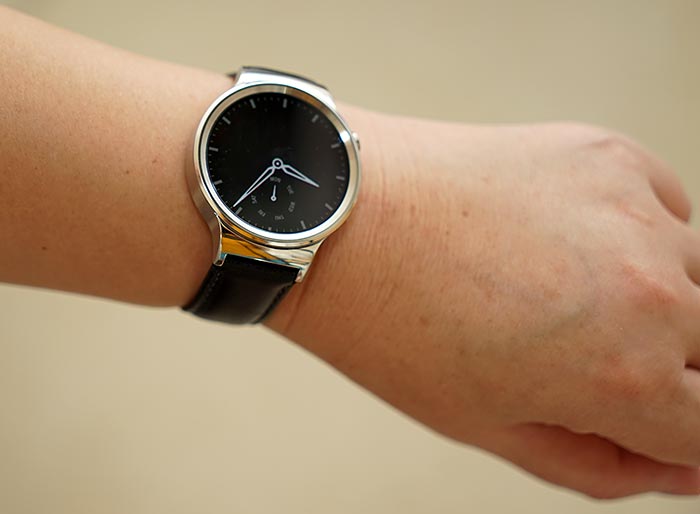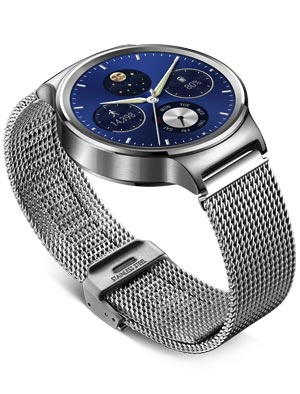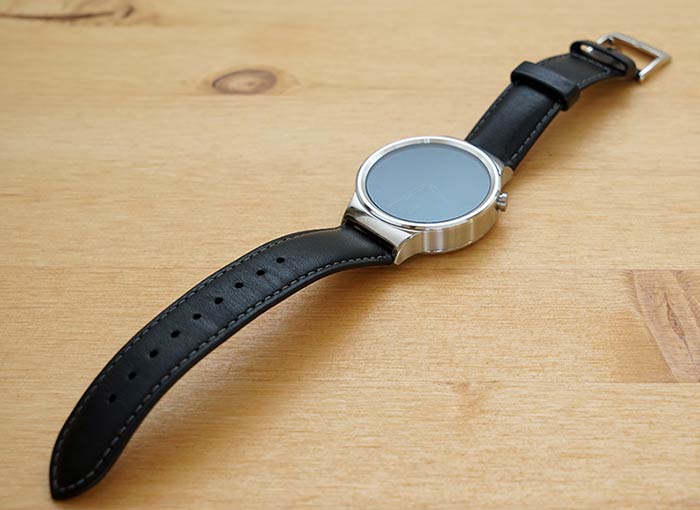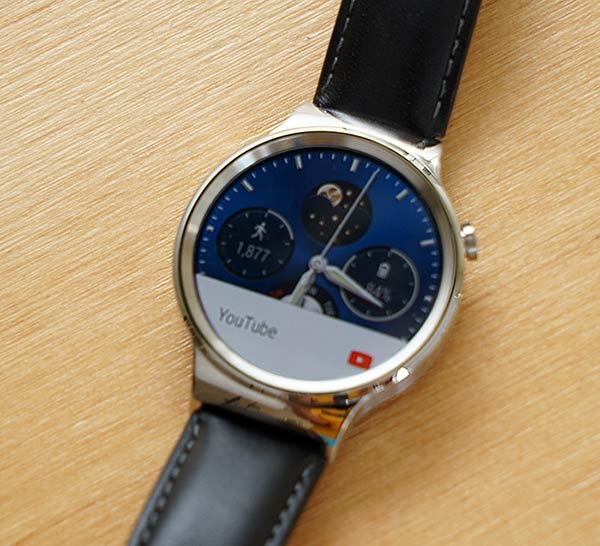
|
|
|||||||
|
Home > Gadget Reviews > Huawei Watch
Huawei Watch
What's Hot: Attractive, watch-like design and stainless steel casing. Sapphire glass protects the display. WiFi extends usable range, supports both Android and iOS. What's Not: Pricey, though you do get a nice metal casing for the price. Large size not friendly to women and smaller boned men. No speaker, no calling, largely still a platform for notifications and Google Now.
Reviewed September 24, 2015 by Lisa Gade, Editor in Chief (twitter: @lisagade)
|
|||||
|
Huawei entered the Android Wear smartwatch arena late, but that might not be a bad thing. The very first watches looked more like Casio sport watches or geek accessories than timeless timepieces. The Moto 360 ushered in the good looking Android Wear watch, though some might call it minimalist while others would call it plain and large by analog watch standards. The Asus ZenWatch was cheaper than the bunch, and it at least had a metal casing and clean lines, though it looked nothing like a traditional watch. So with the second generation of Android Wear watches, Huawei gets to learn from their predecessors' mistakes while taking advantage of significant improvements in Google's Android OS for watches. Oh, and its selection of analog watch faces are simply traditional and gorgeous. Good times. Comfort and Design Despite its manly 42mm size and whopping 11.3mm thickness, the Huawei watch is surprisingly comfortable on my female wrist. It looks too large, but the leather band and metal disk are comfortable enough that I often forgot I was wearing it. That sits in start contrast to the ZenWatch that always reminded me of its weighty presence and the first gen Moto 360 that bonked my wrist bone 20 times per day. I am 5' 10" tall, so my wrists aren't petite. Smaller boned fellas and most women will find the Huawei Watch big looking, as most Android Wear watches are (clearly they're designing them for men, and ample sized fellas at that). When I put the watch on one of our beefier-wristed editors, it looked perfectly sized and at home. To be fair, the need to cram a CPU that was used in phones a few years back, RAM, storage and a battery means these things can only get so small given current technology and reasonable pricing. Only Apple has managed to make something that looks right on the smaller wristed among us with the 38mm Apple Watch. The watch casing is 316L stainless steel with a mix of high polish and satin brush. It looks like a quality piece, and thanks to the materials, round face and overall design, it actually looks like a watch. A thick watch, but definitely a watch and not a geek accessory. The lines are simple and clean, but it doesn't look unstyled by any means. I like it even better than the LG G Watch Urbane (a watch that looks better in photos than in person), and that was one of the more stylish Android Wear watches at introduction.
Pricing and Models Though some might think of Huawei as the new kid on the block in the US, with lower prices befitting a still unproven (in the US) phone maker, their watch costs just as much as the Apple Watch Sport, and the rose gold plated model costs more than the stainless steel Apple Watch. The second gen Moto 360 starts at $299 with a leather band, in contrast, and higher end finishes and bands raise the price into the 300's. The Huawei Watch base price is $349 with a very nice black stitched leather band. If you want it with a stainless steel link band or stainless mesh band, it's $399. The $449 black stainless steel model has a matching DLC coated stainless steel link band. The rose gold plated watch is $699 and if you want a matching plated rose gold link band rather than leather, it's $799. Huawei will sell bands that range in price from $80 to $170, and a spare magnetic charging cradle is $40. Display The watch has a 1.4" OLED touch screen display that's bright enough to see outdoors. The display has a resolution of 400 x 400 and it's completely round with no "flat tire" at the bottom like the first gen Moto 360. As you'd expect with AMOLED, colors are very rich and contrast is high--it makes me wish I could do more with the watch--say watch videos (but that would drain the battery in no time). It has 5 brightness levels, and here in sunny Texas I kept it on 4 or 5 to maintain outdoor visibility. There is no ambient light sensor. The display is covered in sapphire glass, a nice touch for the price.
Here's to Your Health Like many smartwatches, the Huawei Watch has a heart rate scanner. It works similarly to the Apple Watch with an optical scanner on the underside of the watch that glows green while measuring your pulse. The first few days, the watch insisted my heart rate was 95 bpm, which was flat out wrong (external high quality monitors and the Apple watch put it at my usual 65-75 bpm). Reboots didn't fix it, but after 5 days it mysteriously started providing correct readings (no, it didn't get a software update). Lower sweat levels? Solar flares? Who knows, but it works well now. You can use Google Fit with the watch, a step counter that includes where you took those steps if you give consent to Google's location tracking. There are no fancy-pants workout features for biking, rowing machines or other goodies you'd find on a fitness watch or the Apple Watch. You can install 3rd party fitness apps if you find Fit unfit. What's Inside The internals are the near ubiquitous Android Wear combo of the 1.2 GHz Qualcomm Snapdragon 400 CPU, 512 megs of RAM and 4 gigs of flash storage. It's running the latest version of Android Wear, the smaller cousin to Android, and it's among the first with support for syncing to your choice of an Android or Apple smartphone. Like all smartwatches, it's not really all that smart--the phone handles the processing and it sends the data to your watch for anything more than the time of day and heart monitoring (Apple's Watch OS 2.0 actually adds native apps that can do stuff on the watch itself). Android Wear is a second screen for your phone; one that's more accessible since it's not stuffed in your pocket or bag. |
Deals and Shopping:
Advertisement |
||||
|
Huawei Watch Video Review
Android Wear The watch feels snappy and doesn't lag when viewing certainly timely content like weather and stocks (ahem, Apple and your slow stocks and weather). That info isn't always updated as often as it should be (it provided the temperature at 8am, but current time was 3pm), but most of the time it is updated on the proper (frequent) schedule. News, sports scores, weather, stocks and local interesting events are provided by Google Now on your phone, transferred to the watch in tasty bite-sized pieces. You'll use the Android Wear app on your phone to install watch apps, and though Google Play claims 4,000 apps, many of them simply provide watch notifications. Others like Appy Gamer give you a short article synopsis, so you needn't always follow through on your phone. With Gmail, you can scroll through a portion of a new email, and the same is true of text messages.
This is the first of a new breed of Android Wear watches that sync to your choice of and Android smartphone or an iPhone. When paired with an iPhone, the feature set shrinks however, and you mostly just get app notifications piped to the watch. If you're an Android phone user, I'd consider an Android Wear watch, but if you own an iPhone, the reduced functionality makes it less appealing, especially given the capabilities of the Apple Watch. Android OS 5.1.1 on the watch is Google's best iteration of their Android for watches experience. Of course, it's still a very young OS and Android Wear is less than two years old. I've used Android Wear watches since the first models shipped, and I can tell you it's much more fluid, responsive and intuitive now. You have access to installed apps via a long press of the watch's single button, and everything else is done via swipes on the touch screen or your voice or (this is new) a flick of your wrist to scroll notifications. You may look like you're trying to get a wasp off your arm though- it takes a concerted wrist and arm motion. |
Advertisement |
WiFi Means You Can Leave Your Phone on the Desk The OS and watch support WiFi, so you can move beyond Bluetooth's short 30 foot range from the phone and maintain the phone-watch connection. The watch has single band WiFi 802.11b/g, and you'll sync the access point login credentials to the watch using your phone, but the watch and phone don't have to be logged into the same access point. The watch periodically informed me that it had turned WiFi off to conserve power, even though the battery had plenty of charge (annoying).
Android Wear doesn't support cellular connections on the watch nor does it make or receive phone calls as can the Apple Watch and some Samsung Tizen OS smartwatches. In fact, it doesn't support speaker audio of any kind--not even alarms. It does have a vibrate feature, which is fairly weak on the Huawei watch, and it will vibrate to notify you of incoming calls and show the caller's face on-screen (if a caller ID photo is available on your phone). You can however sync music from Google Play Music on your phone to the watch (limited by the 4 gigs of internal storage) and listen to that music using Bluetooth headphones paired with the watch. Battery and Charging The watch comes with a small round magnetic charging plate that has pogo pins that match up with contacts on the watch's back. The magnet helps you to center the watch on the charger and it helps keep the watch and charger connected, but we found that we had to jiggle the pair to get proper contact for charging. I'd rather it be a little more foolproof since many of us aren't wildly alert at bedtime when it's time to charge the watch. The Huawei Watch has a 300 mAh battery and it can actually make it through the night with power to spare should you not get it centered properly on the charger. We found it lasted 1.5 days on a full charge, and these days as long as a smartwatch makes it through a full day, it's considered good (I know, I know, another thing you have to charge religiously). The charger has a standard USB connector and it plugs into the included wall wart (you can use your phone's charger too). Conclusion The Huawei Watch is currently one of the most attractive and classy looking Android Wear watches on the market. I'm sure it will face strong competition as other manufacturers hit the ground running with new models that look more like good quality timepieces (watches are jewelry, after all). I suspect that even with competition, Huawei's watch will hold up well since it uses high quality stainless steel and leathers and a traditional round design. It's also one of the first to support syncing with iOS phones as well as Android phones and WiFi is a blessing if like me, you leave your big phone on the desk and use the watch as a more portable and accessible second screen. On the whole, Android Wear has improved quickly with easier on-watch app access, speed improvements and the always-on low power watch face feature that sure beats staring at a black Apple Watch face. But we'd like to see more content on the watch, speaker audio for alarms and important notifications like incoming calls, not to mention calling on the watch and more advanced exercise and fitness features. Price: $349 to $799 Website: www.gethuawei.com Related Reviews:
|
|




